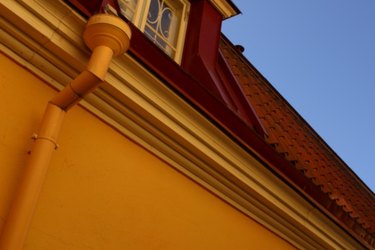Things You'll Need
Metal wire mesh
Staple gun
Hammer
Nails
Ladder
Insulation

Closing off eaves in your attic will help to make your house more energy efficient. Open eaves provide access for the effects of weather. Eaves that are not closed off and that do not have proper insulation can cause energy bills to rise due to heated or cooled air leaking out of the house. Closing off the eaves in your home can be easily done with a little preparation and understanding about how your eaves are built.
Step 1
Clear the area in your attic near the eaves. If there are openings in the attic floors or walls for electrical wiring, plumbing, or cracks in the floor, make sure that they are sealed. Use caulk to seal off these areas.
Video of the Day
Step 2
Cut the wire mesh to fit across the eave opening. You should leave about 1 inch of mesh on each side to help secure the mesh.
Step 3
Place the wire mesh across the opening and secure in place using a staple gun or a hammer and nails. Place the staples or the nails at even intervals across each side of the mesh to ensure its security. The mesh will still allow some air flow from the eaves to the rafters, helping to keep your roof at a temperature consistent with outdoor temperatures, but will not allow birds, most insects, or other animals to enter the attic through the eaves, and will help to reduce lost energy through the eave opening.
Step 4
Install insulation. Insulation in your attic should be laid parallel to the joists in warm climates, perpendicular to the joists if your roof is susceptible to ice dams in the winter. Insulation can be blown in or laid in sheets. Do not cover the eave openings with insulation. The insulation will help to keep your home below the attic at your desired temperature and still allow airflow to keep the roof in good condition.
Tip
Access the eave openings from your attic if possible. Accessing the eave openings from outside can be more difficult when attempting to place the mesh over the openings and it does not allow for the installation of insulation.
Warning
Do not use an insulation that has a vapor barrier or use a vapor barrier in addition to your insulation. Use of a vapor barrier can cause water to condense in your attic leading to rot and water damage.
Video of the Day